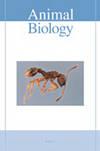饮食反映了亚洲水监测器(Varanus salvator)的机会主义进食习惯
IF 0.9
4区 生物学
Q2 ZOOLOGY
引用次数: 0
摘要
亚洲水蜥(Varanus salvator)是一种大型的多面手掠食者和食腐蜥蜴。本种在南亚和东南亚广泛分布,经常在城市定居点的边缘遇到。在这里,我们介绍了居住在马来西亚大陆东海岸的马来西亚大学登嘉楼校区的亚洲水监测种群的饮食多样性和栖息地利用信息。对30只亚洲水监测仪的胃内容物进行了胃冲洗检查,发现胃内容物中有47.6%为红树林蟹,26.2%为人类粪便,26.2%为其他天然食物,包括水果、鱼类、水蛭、蜗牛、鸟类和昆虫。然后,我们记录了巡逻校园区域所使用的位置和栖息地,发现亚洲水监测员更喜欢使用校园周围交错的水和红树林栖息地。胃内容物的广泛多样性反映了该地点的食物供应,并表明该物种的机会性取食习惯。鉴于该物种广泛分布于东南亚,其广泛的饮食多样性和栖息地变化可能促进亚洲水监测对不同环境的适应。本文章由计算机程序翻译,如有差异,请以英文原文为准。
Diet reflects opportunistic feeding habit of the Asian water monitor (Varanus salvator)
The Asian water monitor (Varanus salvator) is a large generalist predator and scavenger lizard. This species has a widespread distribution throughout South and Southeast Asia and is frequently encountered around the edges of urban settlements. Here, we present information on diet diversity and habitat utilisation of a population of Asian water monitors inhabiting the University of Malaysia Terengganu campus located on the east coast of mainland Malaysia. The stomach contents of 30 Asian water monitors were examined by stomach flushing, and 47.6% of stomach contents was mangrove crab, 26.2% was human waste and 26.2% was other natural foods consisting of fruits, fishes, leeches, snails, birds and insects. We then recorded the locations and habitats utilised by patrolling the campus area and found Asian water monitors preferred to use water and mangrove forest habitats that fringed and crisscrossed the campus. The broad diversity of stomach contents reflected food available at this location and indicates the opportunistic feeding habit of this species. Given that this species widely distributed in Southeast Asia, its broad diet diversity and habitat variations may promote the adaptation of Asian water monitor to different environments.
求助全文
通过发布文献求助,成功后即可免费获取论文全文。
去求助
来源期刊

Animal Biology
生物-动物学
CiteScore
2.10
自引率
0.00%
发文量
34
审稿时长
3 months
期刊介绍:
Animal Biology publishes high quality papers and focuses on integration of the various disciplines within the broad field of zoology. These disciplines include behaviour, developmental biology, ecology, endocrinology, evolutionary biology, genomics, morphology, neurobiology, physiology, systematics and theoretical biology. Purely descriptive papers will not be considered for publication.
Animal Biology is the official journal of the Royal Dutch Zoological Society since its foundation in 1872. The journal was initially called Archives Néerlandaises de Zoologie, which was changed in 1952 to Netherlands Journal of Zoology, the current name was established in 2003.
 求助内容:
求助内容: 应助结果提醒方式:
应助结果提醒方式:


